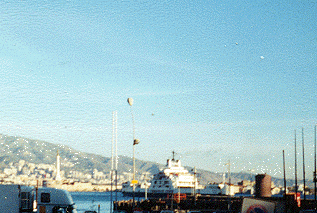History: The ancient name of the city, Zancle, a Greek word meaning "sickle", reflects the unusual curbed shape of the harbor which since antiquity has made it a safe landing-place. In pro-Greek times it was inhabited by Autochtonous people, possible Sicels.
In the 8th century BC Ionians and Chalcidians founded the first urban nucleus between the San Ranieri peninsula and the harbor zone. The town began to grow, favored by trade and port traffic. After the 5th century BC, as a result of internal conflicts, it was destined to alternating vicissitudes. Messenian populations changed its name to Messina. After a period of Cathaginian domination (426 BC), the city achieved its freedom and formed an alliance with Siracusa but, having been recaptured by the Carthaginians, it was destroyed by Himilkon in 396 BC. The new city, rebuilt in the Hellenistic period by Dionysius I of Siracusa, fell once again to the Carthaginians, from whom it was liberated by Timoleon. In 289 the city was occupied by a group of mercenaries from Campania who had been expelled from Siracusa, the Mamertines. When these were on the point of being overcome by the Siracusans and the Carthaginians, they asked Rome for help in 264 BC, the year the First Punic War broke out. Having passed under Roman control in 263 BC, Messina became a federate city. It continued to prosper until the fall of the Western Roman Empire (AD 476).
After the dark period of the Barbarian invasions, Messina returned to splendor in the Byzantine Age, when the trading activities of the port were revived. In 843 it was overcome by the Muslim invaders and the inhabitants fled in mass to Rometta, and organized their resistance. They capitulated only in 965, when they returned to the city and reorganized its layout and social and economic life.
In the Norman period, Messina became one of the most important centers in Sicily. The royal palace was built, the arsenal began to operate and the city defences were strengthened by the extension of of the boundary walls along the entire coast. The building fever continued in the successive Swabian Age, with further developments in town-planning and new development northwards. After the Angevin age and the War of the Sicilian Vespers, in which Messina immediately played an active part and fought strenuously against the oppressor, a new social and economic order was imposed by Frederick of Aragon, and a new city layout was planned.
In the 14th and 15th centuries, a new entrepreneurial bougeois class began to develop, devoted particularly to the silk, leather and wool trade.
In the 15th century, and even more so in the 16th century, the considerable economic development was accompanied by the opening-up of new roads and sqaures and the creation of new areas of expansion.
The anti-Spanish revolt in 1674-78, which was suppressed with great violence, put an end to the idea of making Messina the capital of the vice-royalty of Sicily. The repression of the revolt, the exile of many famillies, and burden of the new taxes and repeated epidemics caused the impoverishment of the city.The earthquake in 1783 was the final blow.
The process of reconstruction was very slow, partly because of continuous polical conflicts and changes in the regime.
In the 19th century, Messina was a declining city.
The achievement of the Unification of Italy, with the sharp gap between north and south, made the situation even worse. A sign of revival, at least on the port activities, was the institution of a regualr ferry service to Calabria, which continues even today.
On 28 December 1908 another violent earthquake almost completely destroyed Messina, killing about 60,000 people. The lengthy and laborious progam of reconstruction aimed at the creation of a city with a modern grid layout, the protection and restoration of the architectural and artistic testimonies that had survived the earthquake and above all at guaranteeing the antiseismic qualities of the new buildings.
Between the 1930s and the 1950s buildings were constructed along the harbor front which, unlike the uninterrupted stretch of houses that had stood there previously, now consisted of individual constructions which reflected the lively artistic and architectural trends of the period.
Of interest: San Raineri lighthouse of tower, built by G. Angelo da Montorsoli (1555), the fort of San Salvatore, designed by Antonio Ferramolino in the 16th century, University of Messina, which boasts a long illustrious tradition. Founded in 1548, Duomo, The original building dates from the Norman Age, from the last years of the reign of Roger II, Fontana di Orione (Fountain of Orion), by Giovanni Angelo Montorsoli (1547-1551), Teatro Vittorio Emanuele, and the Regional Museum. Chiesa di Santa Maria Degli Alemanni, dating from the Swabian period, possibly from the early 13th century.
Events: World Flash Golden Star, in July. International Trade Fair, from 1st to15th of August. Procession of the Giants Mata and Grifone, 13th and 14th August. Procession of the "Vara", 15th August.
The Provincial Archives (Archivio di Stato) and the Archives of the Diocese of Messina are located here.
Families we've researched in these records include the following:
Churches (Messiana Diocese) include the following:
Links to other sites about Messina include:
My latest book on CD is titled Sicily - A Reference for Researchers and is now available. With a file for each town (plus many other files), it relates the history of Sicily as reflected in the photos, records and festivals of its towns. It contains over 2500 text and photo files and can be ordered at CD order.
